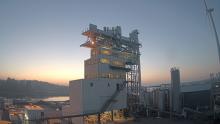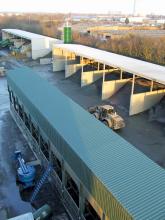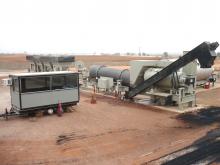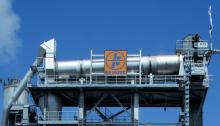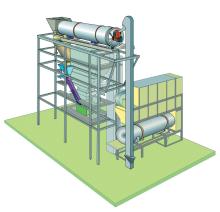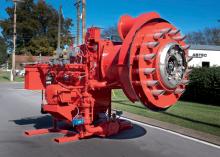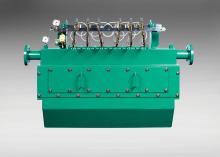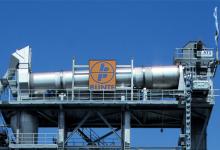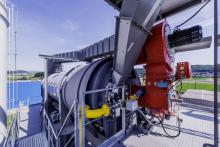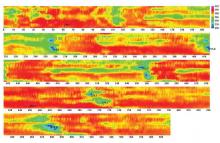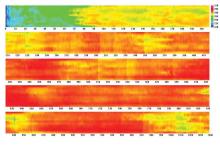The Ammann team was confident it had a game-changer on its stand when the 2007 bauma exhibition opened in Munich. The company’s RAH100 asphalt dryer was about to take a massive step forward for the global highway industry – and to lead the market for years to come
Ammann’s RAH100 wasn’t a simple upgrade of an existing product. It was much bigger than that. The dryer offered the ability to utilise 100% recycled asphalt … a benefit no other competitor could match.
“That 100% utilisation rate was a miles
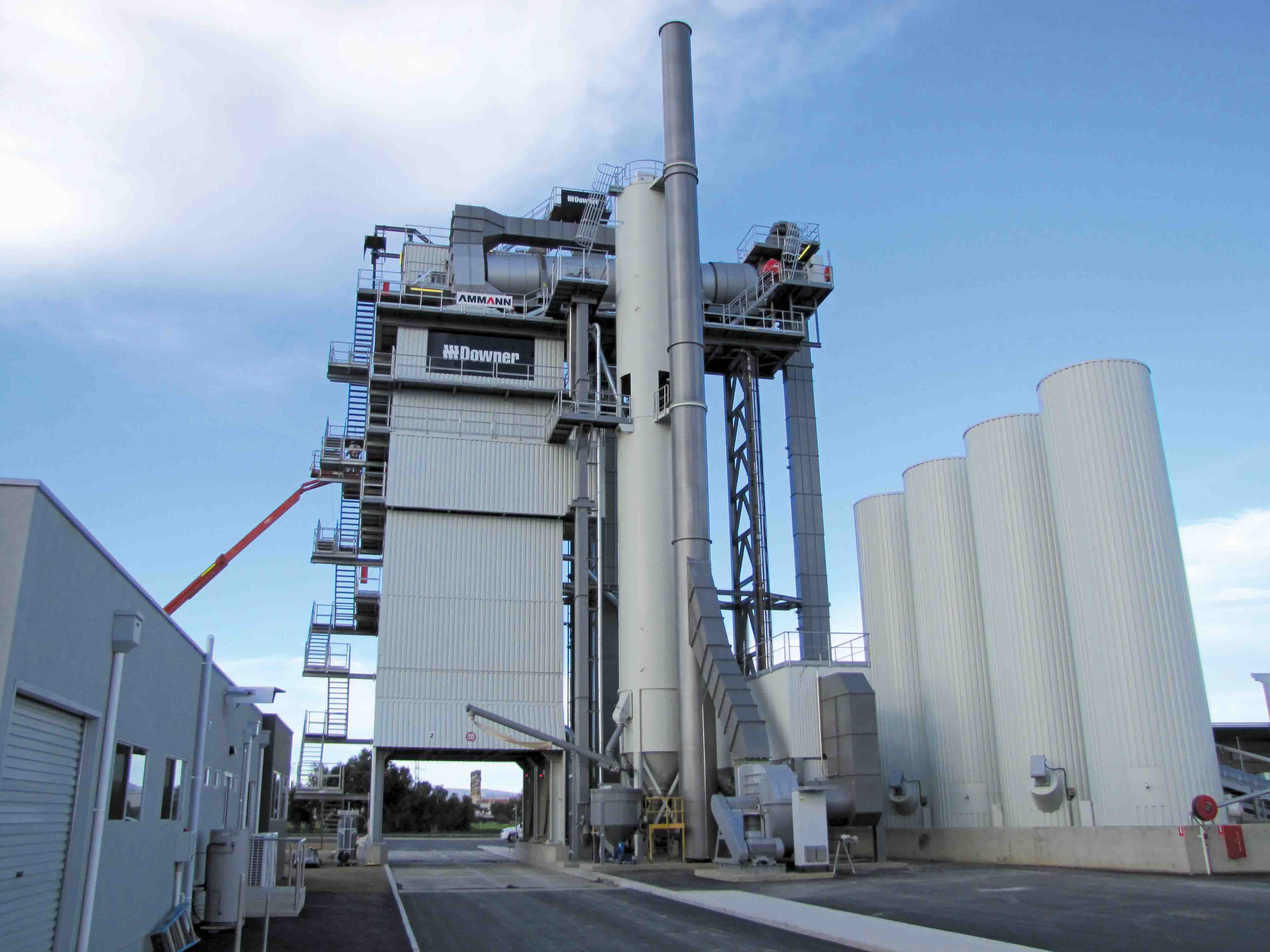
Ammann is well established as a world leader in asphalt plant technology
The Ammann team was confident it had a game-changer on its stand when the 2007 bauma exhibition opened in Munich. The company’s RAH100 asphalt dryer was about to take a massive step forward for the global highway industry – and to lead the market for years to come
6791 Ammann’s RAH100 wasn’t a simple upgrade of an existing product. It was much bigger than that. The dryer offered the ability to utilise 100% recycled asphalt … a benefit no other competitor could match.
“That 100% utilisation rate was a milestone, and Ammann was the first in the industry to achieve it,” said Peter Maurer, Global Commercial Manager for Asphalt Plants at Ammann.
“It (was a benchmark that) set us apart then and has continued to do so ever since. Competitors try to catch us, but we continue to make improvements to what we created back then. We remain confident of our position in the marketplace.”
The previous maximum RAP utilisation rate had been 60%, set years earlier by Ammann. To fully understand the RAH100 and its ability to utilise 100% RAP, it is important to explore the RAH60 and how it reached the 60% mark.
“Temperature is always a key consideration when using RAP,” says Ammann, “because it must be heated to between 120°C and 130°C. The heating is where complications arise. RAP must reach its target temperature, yet it can’t become too hot because bitumen is damaged above 160°C.”
That range is “where the challenge lies with all plants,” says the Swiss-based manufacturer, “especially in the early use of RAP and the development of the RAH60. Bringing RAP to 120°C requires temperatures much higher than 160°C. That means damage is inevitable unless an adjustment is made.”
The Ammann team kept temperature front-of-mind as it considered both parallel-flow and counter-flow dryers for the RAH60. Both approaches raise their own issues.
“With a parallel-flow dryer, the gas (and heat) move in the same direction as the aggregates,” says Ammann. “Specifically, the RAP enters near the burner and is heated as it works its way toward the opposite end before being discharged.”
The dryer is hottest where the RAP enters, and the temperature would have to be well above 160°C
to properly heat the aggregate. Therefore, the parallel process seemed unworkable because bitumen would be damaged upon entry to the dryer.
With a counter flow dryer, the material flows in the opposite direction of the heat, creating the same problem – only at the opposite end. As the material approached the burner near the end of the process, it would be damaged – just before discharge. The Ammann team devised a very creative solution when creating the RAH60.
First, they utilised a parallel-flow system that would not damage the bitumen. What about the issue of the RAP reaching 120°C? This is where the new aggregate came into play.
Fresh aggregate was heated in a different dryer – and at a much higher temperature – because there was no concern about heat damaging the bitumen. After heating, the fresh aggregate was mixed together with the RAP in order to reach the target hot mix temperature. The fresh aggregate was the second heat source.
It was an ingenious solution, to be sure. Those in the industry were thrilled with having to add only 40% new materials. And to this day many plant owners continue to be pleased with this proven process.
Ammann certainly is. The RAH60 remains a very successful and popular product – and its technology is still considered advanced. Even with this accomplishment, the experts at Ammann wanted more. Their goal was a 100% utilisation rate, and they were determined to reach it. How did the team get there? Once again, the use of creative thinking and technology led the way.
Heat again was the challenge. Reaching the 100% goal would mean that the process used by the RAH60 was not an option because no fresh aggregate could be used – and those materials acted as the second heat source. But the team couldn’t go back to the typical counter-flow and parallel-flow systems either, because the issue of burning the bitumen remained.
In some ways, the counter-flow process seemed the best approach, as it didn’t immediately damage the bitumen upon entry like the parallel-flow process did. It also is much more energy efficient than the parallel-flow system.
Eventually the team came upon a solution to create a counter-flow process where the RAP made an “early exit.”
The RAH100 consists of two connected sections. One is a static heat chamber that contains a burner and forces air toward the second section, which is a counterflow dryer. The RAP enters at the far end of the counterflow dryer section and moves toward the heat chamber. Yet it drops out of the dryer before it enters that heat chamber, so it therefore never becomes so hot that it is damaged.
This process eliminates the need for a second heat source, meaning new materials are not needed either. The new process was tested extensively, fine-tuned and ready to go in 2007. The RAH100 was shipped to Munich and set up at the bauma 2007 stand. Visitors inspected the new drum and nearly every person asked the same question: “Can this really use 100% recycled asphalt?”
The answer was a resounding, “yes” and the RAH100 was an immediate success in the marketplace, and for good reason. RAP has been transformed from a waste product to a low-cost aggregate with the added benefit of being pre-coated with expensive bitumen. Customers were happy, as was Ammann. Yet the experts saw challenges – one in particular.
Hot asphalt is sticky, whether coming out of a dryer, being left behind a paver or even when walked upon in a parking lot on a very hot day. The discharge of the RAP from the middle of the dryer meant very sticky material was being handled.
What seemed to be the hardest part of the equation – creating a process in which 100% RAP could be used – had been overcome, but now a side effect had created a new challenge.
The product development team came up with another innovative solution in the form of the Ammann HRT Asphalt-Mixing Plant, unveiled to the public at bauma Munich 2013.
The product team realised that the best way to avoid the blockages was to minimise the transport of the heated RAP from the drum to the mixer. Eventually, it settled on an approach Sir Isaac Newton would appreciate: gravity.
The team developed a plant that positioned the dryer at the very top of the structure. Instead of discharging sticky material to a series of belts, the RAP simply drops out of the dryer into a buffer silo, then the scale and eventually into the mixer below.
This created another set of challenges. While a “falling” approach makes perfect sense, it also requires reconfiguring the plant so the dryer is positioned very high and is aligned with the mixer below it.
This relocation meant other changes – to conveyors that deliver the cool RAP, and to the support system that holds the dryer in place at such an extreme height. But those design challenges were overcome, and the last significant obstacle to 100 per cent recycling was finally conquered.
All of these game-changing asphalt recycling technologies from Ammann are, in truth, a series of improvements, each built on the previous efforts. Without the RAH60 and the scrutiny of its limitations, the RAH100 would have been more difficult – perhaps impossible – to develop.
And without a genuine commitment to constantly improve on an already innovative technology, the HRT plant and the significant benefits it brings would never have made their way to the market.
Such successes can only be accomplished by a team striving for excellence – by individuals who are never satisfied with what is, but are determined to make what is already outstanding even better. As the company said at bauma 2013, Ammann wants to be “a reliable partner with innovative drive, focused on positioning itself as a long-term partner for road builders around the world.” There may well be more game-changers to come.
Images courtesy of www.fotopizza.com
“That 100% utilisation rate was a milestone, and Ammann was the first in the industry to achieve it,” said Peter Maurer, Global Commercial Manager for Asphalt Plants at Ammann.
“It (was a benchmark that) set us apart then and has continued to do so ever since. Competitors try to catch us, but we continue to make improvements to what we created back then. We remain confident of our position in the marketplace.”
The previous maximum RAP utilisation rate had been 60%, set years earlier by Ammann. To fully understand the RAH100 and its ability to utilise 100% RAP, it is important to explore the RAH60 and how it reached the 60% mark.
“Temperature is always a key consideration when using RAP,” says Ammann, “because it must be heated to between 120°C and 130°C. The heating is where complications arise. RAP must reach its target temperature, yet it can’t become too hot because bitumen is damaged above 160°C.”
That range is “where the challenge lies with all plants,” says the Swiss-based manufacturer, “especially in the early use of RAP and the development of the RAH60. Bringing RAP to 120°C requires temperatures much higher than 160°C. That means damage is inevitable unless an adjustment is made.”
The Ammann team kept temperature front-of-mind as it considered both parallel-flow and counter-flow dryers for the RAH60. Both approaches raise their own issues.
“With a parallel-flow dryer, the gas (and heat) move in the same direction as the aggregates,” says Ammann. “Specifically, the RAP enters near the burner and is heated as it works its way toward the opposite end before being discharged.”
The dryer is hottest where the RAP enters, and the temperature would have to be well above 160°C
to properly heat the aggregate. Therefore, the parallel process seemed unworkable because bitumen would be damaged upon entry to the dryer.
With a counter flow dryer, the material flows in the opposite direction of the heat, creating the same problem – only at the opposite end. As the material approached the burner near the end of the process, it would be damaged – just before discharge. The Ammann team devised a very creative solution when creating the RAH60.
First, they utilised a parallel-flow system that would not damage the bitumen. What about the issue of the RAP reaching 120°C? This is where the new aggregate came into play.
Fresh aggregate was heated in a different dryer – and at a much higher temperature – because there was no concern about heat damaging the bitumen. After heating, the fresh aggregate was mixed together with the RAP in order to reach the target hot mix temperature. The fresh aggregate was the second heat source.
It was an ingenious solution, to be sure. Those in the industry were thrilled with having to add only 40% new materials. And to this day many plant owners continue to be pleased with this proven process.
Ammann certainly is. The RAH60 remains a very successful and popular product – and its technology is still considered advanced. Even with this accomplishment, the experts at Ammann wanted more. Their goal was a 100% utilisation rate, and they were determined to reach it. How did the team get there? Once again, the use of creative thinking and technology led the way.
Heat again was the challenge. Reaching the 100% goal would mean that the process used by the RAH60 was not an option because no fresh aggregate could be used – and those materials acted as the second heat source. But the team couldn’t go back to the typical counter-flow and parallel-flow systems either, because the issue of burning the bitumen remained.
In some ways, the counter-flow process seemed the best approach, as it didn’t immediately damage the bitumen upon entry like the parallel-flow process did. It also is much more energy efficient than the parallel-flow system.
Eventually the team came upon a solution to create a counter-flow process where the RAP made an “early exit.”
The RAH100 consists of two connected sections. One is a static heat chamber that contains a burner and forces air toward the second section, which is a counterflow dryer. The RAP enters at the far end of the counterflow dryer section and moves toward the heat chamber. Yet it drops out of the dryer before it enters that heat chamber, so it therefore never becomes so hot that it is damaged.
This process eliminates the need for a second heat source, meaning new materials are not needed either. The new process was tested extensively, fine-tuned and ready to go in 2007. The RAH100 was shipped to Munich and set up at the bauma 2007 stand. Visitors inspected the new drum and nearly every person asked the same question: “Can this really use 100% recycled asphalt?”
The answer was a resounding, “yes” and the RAH100 was an immediate success in the marketplace, and for good reason. RAP has been transformed from a waste product to a low-cost aggregate with the added benefit of being pre-coated with expensive bitumen. Customers were happy, as was Ammann. Yet the experts saw challenges – one in particular.
Hot asphalt is sticky, whether coming out of a dryer, being left behind a paver or even when walked upon in a parking lot on a very hot day. The discharge of the RAP from the middle of the dryer meant very sticky material was being handled.
What seemed to be the hardest part of the equation – creating a process in which 100% RAP could be used – had been overcome, but now a side effect had created a new challenge.
The product development team came up with another innovative solution in the form of the Ammann HRT Asphalt-Mixing Plant, unveiled to the public at bauma Munich 2013.
The product team realised that the best way to avoid the blockages was to minimise the transport of the heated RAP from the drum to the mixer. Eventually, it settled on an approach Sir Isaac Newton would appreciate: gravity.
The team developed a plant that positioned the dryer at the very top of the structure. Instead of discharging sticky material to a series of belts, the RAP simply drops out of the dryer into a buffer silo, then the scale and eventually into the mixer below.
This created another set of challenges. While a “falling” approach makes perfect sense, it also requires reconfiguring the plant so the dryer is positioned very high and is aligned with the mixer below it.
This relocation meant other changes – to conveyors that deliver the cool RAP, and to the support system that holds the dryer in place at such an extreme height. But those design challenges were overcome, and the last significant obstacle to 100 per cent recycling was finally conquered.
All of these game-changing asphalt recycling technologies from Ammann are, in truth, a series of improvements, each built on the previous efforts. Without the RAH60 and the scrutiny of its limitations, the RAH100 would have been more difficult – perhaps impossible – to develop.
And without a genuine commitment to constantly improve on an already innovative technology, the HRT plant and the significant benefits it brings would never have made their way to the market.
Such successes can only be accomplished by a team striving for excellence – by individuals who are never satisfied with what is, but are determined to make what is already outstanding even better. As the company said at bauma 2013, Ammann wants to be “a reliable partner with innovative drive, focused on positioning itself as a long-term partner for road builders around the world.” There may well be more game-changers to come.
Images courtesy of www.fotopizza.com

